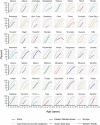Targeting Hypertension Screening in Low- and Middle-Income Countries: A Cross-Sectional Analysis of 1.2 Million Adults in 56 Countries
- PMID: 34212779
- PMCID: PMC8403275
- DOI: 10.1161/JAHA.121.021063
Targeting Hypertension Screening in Low- and Middle-Income Countries: A Cross-Sectional Analysis of 1.2 Million Adults in 56 Countries
Abstract
Background As screening programs in low- and middle-income countries (LMICs) often do not have the resources to screen the entire population, there is frequently a need to target such efforts to easily identifiable priority groups. This study aimed to determine (1) how hypertension prevalence in LMICs varies by age, sex, body mass index, and smoking status, and (2) the ability of different combinations of these variables to accurately predict hypertension. Methods and Results We analyzed individual-level, nationally representative data from 1 170 629 participants in 56 LMICs, of whom 220 636 (18.8%) had hypertension. Hypertension was defined as systolic blood pressure ≥140 mm Hg, diastolic blood pressure ≥90 mm Hg, or reporting to be taking blood pressure-lowering medication. The shape of the positive association of hypertension with age and body mass index varied across world regions. We used logistic regression and random forest models to compute the area under the receiver operating characteristic curve in each country for different combinations of age, body mass index, sex, and smoking status. The area under the receiver operating characteristic curve for the model with all 4 predictors ranged from 0.64 to 0.85 between countries, with a country-level mean of 0.76 across LMICs globally. The mean absolute increase in the area under the receiver operating characteristic curve from the model including only age to the model including all 4 predictors was 0.05. Conclusions Adding body mass index, sex, and smoking status to age led to only a minor increase in the ability to distinguish between adults with and without hypertension compared with using age alone. Hypertension screening programs in LMICs could use age as the primary variable to target their efforts.
Keywords: cardiovascular disease; epidemiology; low‐ and middle‐income countries; noncommunicable diseases; prevention.
Conflict of interest statement
None.
Figures



References
-
- The World Bank . Projections of mortality and causes of death, 2016 to 2060 by World Bank income groups. Published 2019. http://www.who.int/healthinfo/global_burden_disease/projections/en/. Accessed March 1, 2019.
-
- Yusuf S, Hawken S, Ôunpuu S, Dans T, Avezum A, Lanas F, McQueen M, Budaj A, Pais P, Varigos J, et al. Effect of potentially modifiable risk factors associated with myocardial infarction in 52 countries (the INTERHEART study): case‐control study. Lancet. 2004;364:937–952. DOI: 10.1016/S0140-6736(04)17018-9. - DOI - PubMed
-
- O'Donnell MJ, Chin SL, Rangarajan S, Xavier D, Liu L, Zhang H, Rao‐Melacini P, Zhang X, Pais P, Agapay S, et al. Global and regional effects of potentially modifiable risk factors associated with acute stroke in 32 countries (INTERSTROKE): a case‐control study. Lancet. 2016;388:761–775. DOI: 10.1016/S0140-6736(16)30506-2. - DOI - PubMed
Publication types
MeSH terms
Grants and funding
LinkOut - more resources
Full Text Sources
Medical
Research Materials

